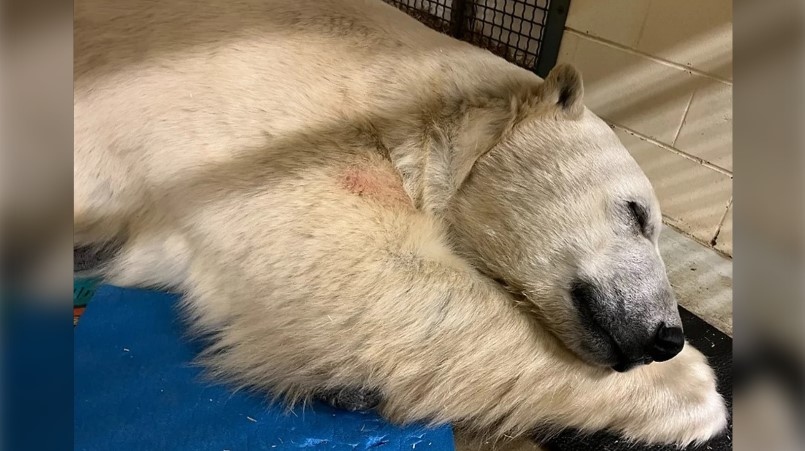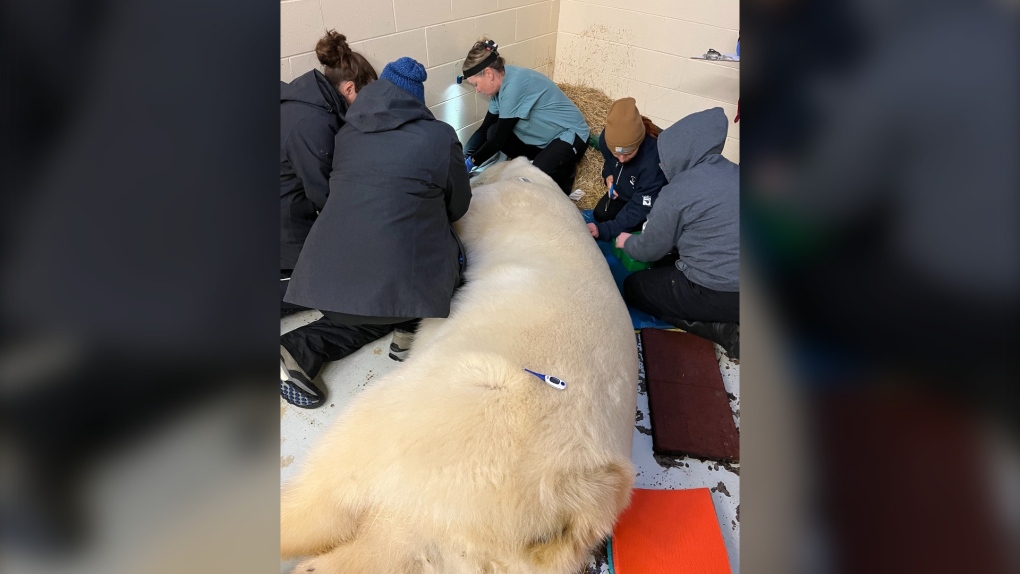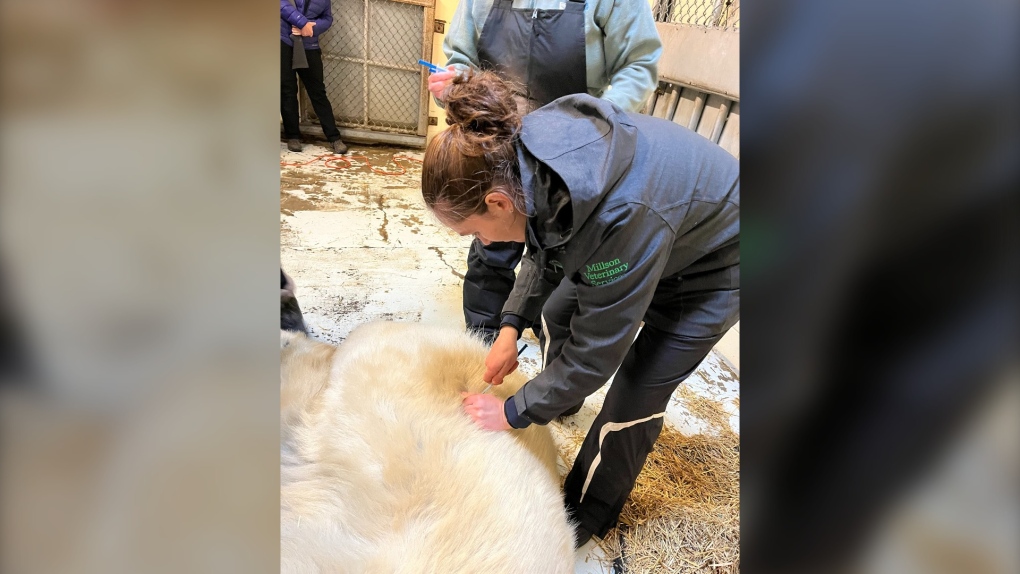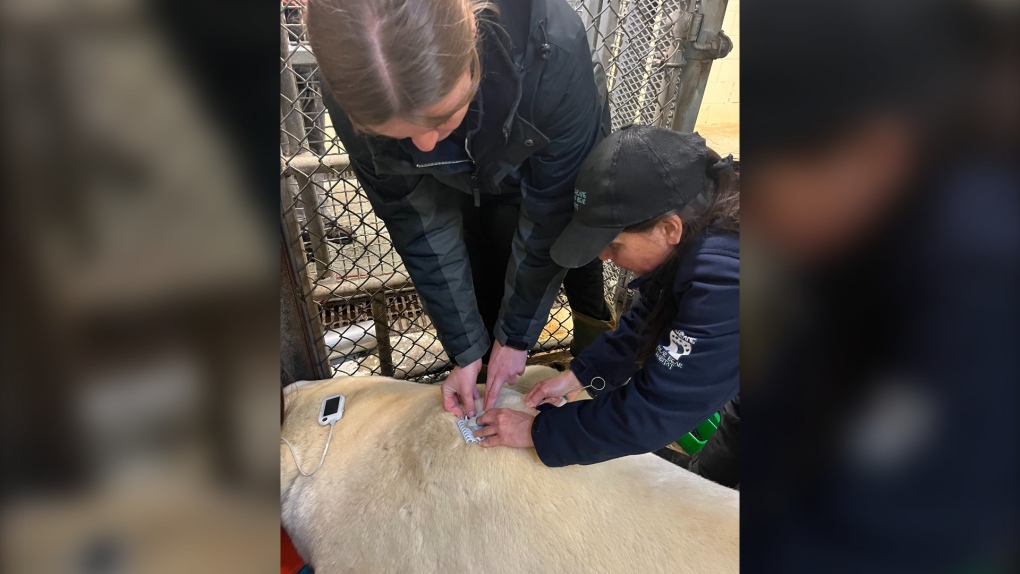Polar bears at northern Ont. sanctuary undergo health checks under sedation
Last weekend, the three resident polar bears at a northern Ontario sanctuary located in Cochrane underwent extensive health exams under sedation, including allergy tests an X-rays.
 Ganuk sleeping comfortably after his procedure. (Cochrane Polar Bear Habitat)
Ganuk sleeping comfortably after his procedure. (Cochrane Polar Bear Habitat)
A team of experts from across the province assembled to help the animal care team at the Cochrane Polar Bear Habitat, including the National Wildlife Centre Canada, Bear With Us Centre for Bears, King Animal Hospital, Millson Veterinary Services and the Ministry of Natural Resources and Forestry.
Interestingly, the 1,000-pound polar bears allow their caretakers to perform routine veterinary procedures -- such as administering annual vaccinations, ultrasounds and drawing blood -- without any sedation.
"While our bears are highly trained to voluntarily partake in many behaviours that allow us to care for them without the need for sedation, there were some procedures that require them to be asleep," Cochrane Polar Bear Habitat said in a news release.
"We are thrilled to report that each bears' procedure was conducted without complications and they are well on the way to recovery."
THE BEARS
The trio of bears at the habitat are all male and includes 10-year-old Henry from Sea World in Australia, and father and son 20-year-old Inukshuk and 13-year-old Ganuk.
Inukshuk was orphaned in the wild of the Far North and spent nearly nine years at Toronto Zoo before moving to the habitat.
His son, Ganuk, is the longest habitat resident and largest bear. He was born at a Quebec zoo with his twin sister.
POLAR BEAR ALLERGY TEST
Ganuk was experiencing symptoms that were suspected to be seasonal allergies, so Toronto veterinary dermatologist Dr. Stephen Waisglass conducted a scratch test.
 Ganuk receiving an allergy test from Dr. Waisglass and his team. (Cochrane Polar Bear Habitat)
Ganuk receiving an allergy test from Dr. Waisglass and his team. (Cochrane Polar Bear Habitat)
Similar to a human test, a series of potential allergens were administered to his skin, which was observed for reactions such as swelling or redness.
"The test results were somewhat inconclusive, but we will continue to investigate using other testing methods," the habitat said.
ARTHRITIS TREATMENT
Inukshuk is considered a senior bear.
"Over the past couple of months, Inukshuk has shown some stiffness in his front right leg when first getting up in the morning, which could be indicative of arthritis," the habitat said.
"He has been receiving a daily dose of glucosamine supplement, similar to Ganuk, since we started to see the stiffness, but we also wanted to see what may be happening in his joints."
X-rays were taken of his front legs and confirmed some changes in the bone.
"We will continue to provide supportive joint treatment and we remain optimistic with the improvement we have seen," the habitat said.
- Download the CTV News app now
- Get local breaking news alerts
- Daily newsletter with the top local stories emailed to your inbox
NEW TRACKING DEVICE
While the bears were sedated, they were fitted with new tracking devices called Burr on Fur as part of a conservation project led by Polar Bears International.
 The Burr on Fur tracking device. (Cochrane Polar Bear Habitat)
The Burr on Fur tracking device. (Cochrane Polar Bear Habitat)
The device attaches to the fur between the bear's shoulder blades and is designed to fall off naturally when they shed in the spring.
"Bears in human care centres play a vital role in conservation projects such as this, as we can monitor them on a longitudinal basis that is just not possible in the wild," the habitat said.
"Not only can we closely observe the equipment to judge its efficacy over time, but we can assess a bears' reaction to ensure that it does not affect their day-to-day activities and behaviour."
 Henry under sedation, being kept safe by Dr. Cox. (Cochrane Polar Bear Habitat)
Henry under sedation, being kept safe by Dr. Cox. (Cochrane Polar Bear Habitat)
 Polar bears at Cochrane Polar Bear Habitat undergo health checks under sedation
Polar bears at Cochrane Polar Bear Habitat undergo health checks under sedation
 Gail and Kearin fitting the Burr on Fur (Cochrane Polar Bear Habitat)
Gail and Kearin fitting the Burr on Fur (Cochrane Polar Bear Habitat)
CTVNews.ca Top Stories

Federal government's two-month GST holiday begins
As a two-month break from the federal GST took effect Saturday, shoppers and businesses expressed lukewarm support for the measure.
Former Manhattan prosecutor to represent suspect in killing of UnitedHealthcare’s CEO
The suspect in the killing of UnitedHealthcare's CEO has added a prominent defense lawyer to his legal team as Manhattan prosecutors work to return him from Pennsylvania to face a murder charge.
British departure means uncertain future for Alberta's massive Suffield military base
A sprawling military training base more than twice the size of New York City in southeastern Alberta appears to be a shadow of its former self while its future use remains up in the air.
Enbridge pipeline spills 70,000 gallons of oil in Wisconsin
Roughly 70000 gallons (264,978 litres) of oil from a pipeline spilled into the ground in Wisconsin, officials said.
Pop music is messier — for the better — because of Chappell Roan, Charli XCX and Sabrina Carpenter
The year 2024 arguably belonged to the three rising pop stars whose songs took us out to the clubs (Pink Pony and otherwise) and back home to the bedroom.
Women's right activists rally in France ahead of Gisèle Pelicot's rape trial verdict
Hundreds of people gathered Saturday in the southern French town of Avignon ahead of the verdict in a trial in which dozens of men are accused of rape.
Shoppers raise complaints after being charged twice for Walmart purchases
A Saskatchewan shopper is out more than $200 after being charged twice for her grocery purchase at a Regina Walmart.
Two Montreal anesthesiologists suspended for questionable practices: College of Physicians
Two anesthesiologists at Montreal’s Royal Victoria Hospital were brought before the Quebec College of Physicians disciplinary board for questionable practices and were suspended.
Winnipeg man charged after attempting to flee from police in stolen vehicle
Winnipeg police arrested and charged a 24-year-old man after he allegedly rammed a stolen vehicle into a police cruiser.






























